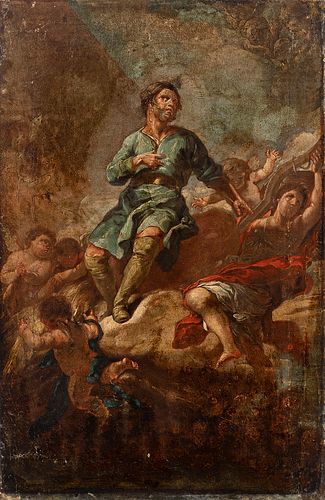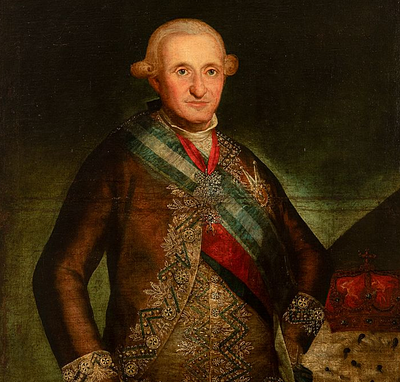Attributed to CORRADO GIAQUINTO (Italy, 1703 - 1765/66). "San Isidro the farmer." Oil on canvas. Relined.
Lot 27
About Seller
Setdart Auction House
Carrer Aragó 346
Barcelona
Spain
Setdart Subastas was born in 2004 and is currently the first online art auction in Spain with solidity, prestige and reliability guaranteed by our more than 60,000 users. Setdart has a young, dynamic and enterprising team ready to successfully manage the purchase and sale of art works through custom...Read more
Estimate:
EUR€11,000 - EUR€12,000
$11,340.21 - $12,371.13
Absentee vs Live bid
Two ways to bid:
- Leave a max absentee bid and the platform will bid on your behalf up to your maximum bid during the live auction.
- Bid live during the auction and your bids will be submitted real-time to the auctioneer.
Bid Increments
| Price | Bid Increment |
|---|---|
| EUR€0 | EUR€10 |
| EUR€200 | EUR€25 |
| EUR€500 | EUR€50 |
| EUR€1,000 | EUR€100 |
| EUR€3,000 | EUR€200 |
| EUR€5,000 | EUR€500 |
| EUR€10,000 | EUR€1,000 |
| EUR€20,000 | EUR€2,000 |
| EUR€50,000 | EUR€5,000 |
About Auction
By Setdart Auction House
Sep 22, 2021
Set Reminder
2021-09-22 09:30:00
2021-09-22 09:30:00
America/New_York
Bidsquare
Bidsquare : 22nd September - ARAS JÁUREGUI Private Collection - Old Masters, 19th & 20th Century
https://www.bidsquare.com/auctions/setdart-auction-house/22nd-september---aras-j-uregui-private-collection---old-masters-19th-20th-century-7427
ARAS JÁUREGUI Private Collection - Old Masters, 19th & 20th Century Setdart Auction House sofia@setdart.com
ARAS JÁUREGUI Private Collection - Old Masters, 19th & 20th Century Setdart Auction House sofia@setdart.com
- Lot Description
Attributed to CORRADO GIAQUINTO (Italy, 1703 - 1765/66). "San Isidro the farmer." Oil on canvas. Relined. It presents faults and repainting. It needs to be cleaned. Measurements: 52,5 x 34 cm. The present work represents the apotheosis of San Isidro, this one follows faithfully the models established by Corrado Giaquinto, in the fresco carried out for the chapel of the Royal Palace of Madrid, painted by the Italian artist between 1759 and 1760. The work also bears a close resemblance to a work on the same theme in the collection of the Museo de San Isidro in Madrid, and to the sketch of the fresco mentioned above, which is in the Casita del Príncipe in El Escorial. It is interesting to mention the representation of the Apotheosis of the Saint, as this iconographic pattern had only previously been used to decorate the ephemeral architecture of the saint's festivities in 1620. But it was not repeated until the 18th century, when Van Loo chose the theme to decorate the Church of San Isidro in Rome. In Spain, however, it was Corrado Giaquinto who introduced this representation of the saint, making it a success. San Isidro Labrad (Madrid, 1080-1172) was beatified by Paul V in 1619 and canonised in 1622 by Gregory XV. He was declared patron saint of Spanish farmers by John XXIII in 1960. Several miracles are attributed to this saint, among the most famous being that of the well in which, thanks to his prayer, the waters rose so that his son, who had fallen in, could be rescued. Another is the one in which the angels help the saint to plough a field, thus allowing him to stop and pray in all the parishes he passed through on his way to work. His iconographic representation is directly related to his work as a farmer, his most frequent symbols being the tools of the field, such as the hoe or the spade. He is also often depicted with a rosary, grilles or ears of corn. Due to its formal characteristics, the present work is attributed to Corrado Giaquinto, an Italian painter of the 18th century who is considered to be the leading representative of Rococo painting in Rome at the time. Due to his compositional mastery and masterful use of colour, the Italian artist became a point of reference for several generations of Spanish painters. The leading representative of Rococo painting in Rome in the first half of the 18th century, Giaquinto's work was a point of reference for several generations of Spanish painters. Appointed painter to Ferdinand VI in 1753 and until 1762, he was also artistic director of the Royal Tapestry Factory of Santa Barbara and director general of the San Fernando Royal Academy of Fine Arts. His language, which began with rococo and evolved in an increasingly classical direction, is characterised by a great sense of scenography and chromatic subtleties of extraordinary beauty. These two features are clearly evident here; the composition is totally theatrical, with the clarity of classicism combined with the elegant and graceful dynamism of rococo. The stage is organised in depth, playing with the position of the cumulus clouds and seeking a naturalistic representation of the space, with a sense of scenography inherited from the Baroque period. Giaquinto's is a classically influenced rococo, and his works will increasingly denote a more solid classicism: compositions of greater spatial clarity, as we see here, populated by solemn figures with lively gestures.
- Shipping Info
-
In-house shipping available. Please inquire at admin@setdart.com.
-
- Buyer's Premium



 EUR
EUR CAD
CAD AUD
AUD GBP
GBP MXN
MXN HKD
HKD CNY
CNY MYR
MYR SEK
SEK SGD
SGD CHF
CHF THB
THB

















